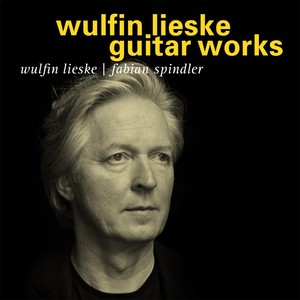
Wulfin Lieske Guitar Works
- 流派:Jazz 爵士
- 语种:英语
- 发行时间:2017-03-01
- 类型:录音室专辑
- 歌曲
- 时长
-
Four Bagatelles on 52
-
Vocalise dt Fureur
-
Astoriana
简介
Nympheás d’aprés Claude Monet was composed in January 2003 and was inspired by the painter’s late water lily pictures. As Monet confined himself to various shades of blue, the composition is based on a tapestry of eight tones, which despite the peaceful and improvised attitude of the work, is structured very rigorously – almost serially. In this respect it is similar to the complex knotting technique of an Oriental kelim and leads to a state of ‘meditative ecstasy’ as similarly manifested by Monet. The number 8 symbolises infinity and also the element water. “Nympheás” thus continues the series of “Water compositions”, which also includes the “Over the Waters” oratorio premièred at the EXPO 2000 in Hanover and choral work on Goethe’s “Song of the Spirits over the Waters” composed in 2001. "Four Bagatelles on 52" (1998) - four solo pieces of moderate difficulty resulted from work on my composition “52stein” work – based on the same series of 52 tones. After the first lyrical miniature, the second movement – in homage to György Kúrtag – is devoted to expressions of extreme states, from stasis to eruptive drama. This is followed by a toccato-like chord study in a rigorous metric-processual structure that intensifies from regular beats to highly virtuoso arpeggios. The finale is formed by a cavatina as homage to my friend, sculptor Barna von Sartory, in which the series is played backwards. The two-movement work "Vocalise et Fureur" is a tribute to Olivier Messiaen. In the first part an unending melody develops from diatonic fragments in the viola part, accompanied by an ostinato-like six-part chord in staccato. The harmony reflects the melody. The second movement is a motoric ‘perpetuum mobile’. The canonically dovetailed chord figurations are developed from the melody in the first movement. Polyrhythmic superimpositions and permissive sforzati evoke an oppressively tense mood. In the first part an unending melody develops from diatonic fragments … "Violet" was composed to mark a memorial performance for the famous guitar builder, Antonio de Torres with his legendary instrument "La Leona" from 1856. The concert was held on 25 May 2006 in the cathedral of his birthplace, Almeria (Spain). The work unites the spiritual and romantic qualities of this instrument and develops an almost orchestral scape in four closely spaced sequences. Slowly spiralling the "Genesis" emerges from the highest heights to the bass H of the guitar scordatura, running into a lively "funky"-like " fencing bout and a virtuoso eruption of "heavy metal" (scherzo). Following the dramatic climax comes a contemplative and very variegated apotheosis, in which a melody soars up from distant ages. The term "Violet (purple)" combines "viola" and "violence" and addresses the fluid transition in Romanticism from beauty to passion (the colour purple) and its escalation into destructive violence. "Astoriana" - in autumn 2000, working on a duo concept for Gruber & Maklar, I was preoccupied with the question of how brilliant guitar music can be created while at the same time reflecting part of a typical guitar repertoire. I decided to pay tribute to a venerable master, who - alongside Heitor Villa-Lobos and Léo Brouwer - ranks among the greats of guitar music: Astor Piazzolla. His music, in countless transcriptions and some original compositions, figures prominently on guitar and other recital programmes (my own included). His high charismatic recall level derives already from small rhythmic-harmonic motifs and runs through the majority of his works - and in this respect he is very much related to Antonio Vivaldi, whom he rivals in popularity. These very characteristic expressions - we might say “Piazzollarisms” - tempted me to compose a work of my own, based on ‘clichés’ from his music, though not necessarily appropriations. Astoriana is structured in movements; Inventio accentuato - Chiaccona metamorphica - Allegro fugitivo. Beyond the obvious presence of Piazzollarisms, each movement also contains a specific thematic reference to one of his compositions.

